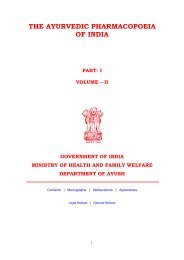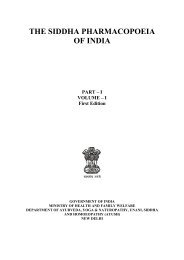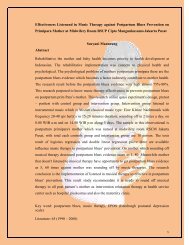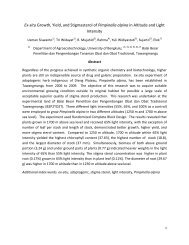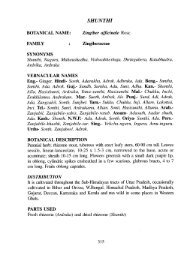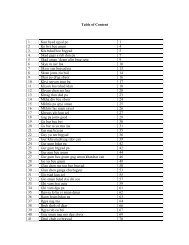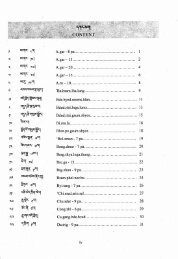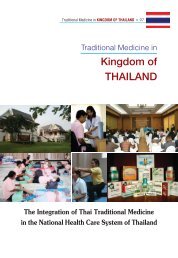Notes on the genus Kaempferia L. (Zingiberaceae) in Thailand
Notes on the genus Kaempferia L. (Zingiberaceae) in Thailand
Notes on the genus Kaempferia L. (Zingiberaceae) in Thailand
You also want an ePaper? Increase the reach of your titles
YUMPU automatically turns print PDFs into web optimized ePapers that Google loves.
¯apple<br />
«“√ “√°“√·æ∑¬å·ºπ‰∑¬·≈–°“√·æ∑¬å∑“߇≈◊Õ° ªï∑’ Ë ˆ©∫—∫∑’ Ë Ò ¡°√“§¡ - ‡¡…“¬π ÚııÒ<br />
Bull. (Bot.) 19: 5. 1992.<br />
Type: <strong>Thailand</strong>, Phu Wat (Mukdahan Prov<strong>in</strong>ce), Kerr<br />
21500 (holotype K)<br />
This tax<strong>on</strong> was described from <strong>the</strong> specimen<br />
collected by A.F.G. Kerr <strong>in</strong> 1932 from çPu Wat (Nakawn<br />
Panom)é, which is nowadays Phu Wat of Mukdahan<br />
Prov<strong>in</strong>ce <strong>in</strong> nor<strong>the</strong>astern <strong>Thailand</strong>. The type specimen<br />
was described as closely related to K. fissa<br />
Gagnep. and K. fallax Gagnep, but it differs <strong>in</strong> <strong>the</strong><br />
larger habits and an<strong>the</strong>r crests. All three taxa possess<br />
pure white, night-bloom<strong>in</strong>g flowers. The c<strong>on</strong>nective<br />
appendage of this tax<strong>on</strong> may be described as rectangular<br />
with bifurcate apex, while those of <strong>the</strong> two latter<br />
species are short bifurcate and square respectively.<br />
However, <strong>the</strong>se characters, which are used for<br />
tax<strong>on</strong>omic decisi<strong>on</strong>-mak<strong>in</strong>g, are variable, especially<br />
<strong>the</strong> length of <strong>the</strong> leaves and corolla tubes.<br />
Dur<strong>in</strong>g <strong>the</strong> past few years, <strong>the</strong> authors have made<br />
several visits to <strong>the</strong> sites of this tax<strong>on</strong> <strong>in</strong> Phu Phan<br />
Nati<strong>on</strong>al Park (Sak<strong>on</strong> Nakh<strong>on</strong> Prov<strong>in</strong>ce), Phu Wat (type<br />
locati<strong>on</strong>, formerly Nakh<strong>on</strong> Phanom, but now Mukdahan<br />
Prov<strong>in</strong>ce), Kh<strong>on</strong>g Chiam and Sir<strong>in</strong>dhorn Districts<br />
(Ub<strong>on</strong>ratchathani Prov<strong>in</strong>ce), <strong>in</strong>clud<strong>in</strong>g several o<strong>the</strong>r<br />
locati<strong>on</strong>s <strong>in</strong> sou<strong>the</strong>rn Laos, to m<strong>on</strong>itor and study <strong>the</strong><br />
liv<strong>in</strong>g populati<strong>on</strong>s. At this stage we suspect that this<br />
species may be c<strong>on</strong>specific to K. fissa Gagnep. A<br />
molecular study to c<strong>on</strong>firm our hypo<strong>the</strong>sis is <strong>in</strong><br />
progress.<br />
6. K. galanga L., Sp. Pl.: 2. 1753; Roxb., Pl. Ind. 1: 5.<br />
1820; Bak. <strong>in</strong> Hook., Fl. Br. Ind. 6: 218. 1890; Schum.<br />
<strong>in</strong> Engl., Pflanzenr. 4(46), 20 Heft: 77. 1904; Gagnep.<br />
<strong>in</strong> Lecomte, Fl. Gén. I.-C. 6: 45. 1908; Ridl., Fl. Mal.<br />
Pen. 4:245. 1924; Holtt. <strong>in</strong> Gard. Bull. S<strong>in</strong>g. 13:117.<br />
1950; Larsen <strong>in</strong> Bot. Tidsskr. 58: 201. 1962; Chung,<br />
Lime. Fl. Mal. 2: 703. 1973; Burtt & Smith <strong>in</strong><br />
Dassanayake, Fl. Cey. 4: 508. 1983; Sirirugsa <strong>in</strong> Nord.<br />
J. Bot. 9: 259. 1989 & <strong>in</strong> Thai For. Bull. (Bot.) 19: 11.<br />
1992; T.L.Wu & K.Larsen <strong>in</strong> Z.L.Wu & PH. Raven, Fl.<br />
Ch<strong>in</strong>a 24: 369. 2000.––K. sessilis König <strong>in</strong> Retz., Obs.<br />
3: 67. 1783.––K. humilis Salisb., Prodr. 6. 1796.––K.<br />
plantag<strong>in</strong>ifolia Salisb. <strong>in</strong> Trans. Hort. Soc. 1: 286. 1808.<br />
Type: probably Hort. Cliff.<br />
This generic type species is <strong>on</strong>e of <strong>the</strong> important<br />
medic<strong>in</strong>al plants used <strong>in</strong> Thai traditi<strong>on</strong>al medic<strong>in</strong>e.<br />
It can be readily dist<strong>in</strong>guished from o<strong>the</strong>r taxa<br />
by its two horiz<strong>on</strong>tal (flat <strong>on</strong> <strong>the</strong> ground), ovate-tosuborbicular,<br />
unequal-side, sessile leaves with <strong>in</strong>florescence<br />
enclosed <strong>in</strong> <strong>the</strong> two leaf-sheaths, and white<br />
flowers. The lateral stam<strong>in</strong>odes are obovate-cuneate<br />
or oblanceolate and <strong>the</strong> labellum is divided to <strong>the</strong><br />
base with a purple blotch at <strong>the</strong> base. The an<strong>the</strong>r<br />
crest is 4-5 × 2-3 mm, deeply bilobed, each lobe be<strong>in</strong>g<br />
rounded or unequally too<strong>the</strong>d.<br />
This tax<strong>on</strong> is distributed over a wide range: from<br />
India to Myanmar, Ch<strong>in</strong>a, <strong>Thailand</strong>, Indoch<strong>in</strong>a, Malay<br />
Pen<strong>in</strong>sula and Java. It can be found <strong>in</strong> bamboo forests,<br />
often <strong>in</strong> evergreen and deciduous forests, <strong>in</strong> all<br />
parts of <strong>Thailand</strong>. It is widely cultivated <strong>in</strong> Thai home<br />
gardens as <strong>the</strong> leaves and rhizomes are used for food<br />
and medic<strong>in</strong>e.<br />
7. K. glandifolia Saensouk & Jenjitt. <strong>in</strong> Nord. J. Bot.<br />
21: 139-140, Figs. 1-2. 2001.<br />
Type: <strong>Thailand</strong>, Kh<strong>on</strong> Kaen Prov<strong>in</strong>ce, Kok Phu Takla,<br />
Saensouk 55 (holotype BKF)<br />
This unique species can be readily dist<strong>in</strong>guished<br />
by its <strong>in</strong>florescences <strong>on</strong> separate shoots aris<strong>in</strong>g from<br />
rhizomes appear<strong>in</strong>g before <strong>the</strong> pseudostems, <strong>the</strong> 4-5<br />
large (12.5-20 × 15-20 cm) almost horiz<strong>on</strong>tal (near <strong>the</strong><br />
ground) suborbicular leaves, and <strong>the</strong> pedunculated<br />
(0.5-3 cm) <strong>in</strong>florescences with pure white flowers. The<br />
an<strong>the</strong>r crest of <strong>the</strong> flower is obl<strong>on</strong>g with a c<strong>on</strong>spicuously<br />
bilobed apex.<br />
So far <strong>the</strong> tax<strong>on</strong> is known <strong>on</strong>ly from <strong>the</strong> type<br />
locati<strong>on</strong> <strong>in</strong> a restricted area of Kh<strong>on</strong> Kaen Prov<strong>in</strong>ce <strong>in</strong><br />
nor<strong>the</strong>astern <strong>Thailand</strong>. The leaves and rhizomes are<br />
used by <strong>the</strong> local people for medic<strong>in</strong>al purposes.<br />
8. K. glauca Ridl. <strong>in</strong> J. Asiat. Soc. Bengal: 107. 1899;<br />
Schum. <strong>in</strong> Engl., Pflanzenr. 4(46), 20 Heft: 78. 1904;<br />
Gagnep. <strong>in</strong> Lecomte, Fl. Gén. I.-C. 6: 51. 1908; Sirirugsa<br />
<strong>in</strong> Nord. J. Bot. 9: 259. 1989 & <strong>in</strong> Thai For. Bull. (Bot.)<br />
19: 13. 1992.



